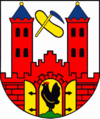House of Henneberg
Henneberg was a medieval German comital family (Grafen) which from the 11th century onwards held large territories in the Duchy of Franconia. Their county was raised to a princely county (Gefürstete Grafschaft) in 1310.
| Henneberg | |
|---|---|
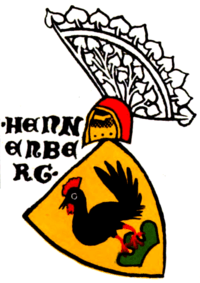 | |
| Parent house | Babenberg in turn from the Robertians |
| Titles | Princely Counts of Henneberg |
| Estate(s) | County of Henneberg |
(Princely) County of Henneberg (Gefürstete) Grafschaft Henneberg (de) | |||||||||||||
|---|---|---|---|---|---|---|---|---|---|---|---|---|---|
| c. 1037–1660 | |||||||||||||
Coat of arms
| |||||||||||||
 County of Henneberg around 1350 | |||||||||||||
| Status | Principality | ||||||||||||
| Capital | Henneberg Schleusingen Römhild | ||||||||||||
| Common languages | East Franconian | ||||||||||||
| Government | Principality | ||||||||||||
| Historical era | Middle Ages, Renaissance | ||||||||||||
• Poppo I, first count | c. 1037 | ||||||||||||
• Internally divided | 1274 | ||||||||||||
• Raised to principality | 1310 | ||||||||||||
| 1500 | |||||||||||||
• Schleusingen branch extinct | 1583 | ||||||||||||
• Divided | 1660 | ||||||||||||
| |||||||||||||
Upon the extinction of the line in the late 16th century, most of the territory was inherited by the Saxon House of Wettin and subsequently incorporated into the Thuringian estates of its Ernestine branch.
Origins
The distant origins of this family are speculative yet seem to originate in the Middle Rhine Valley, east of modern-day France. Charibert, a nobleman in Neustria is the earliest recorded ancestor of the family, dating before 636. Five generations pass between Charibert and the next descendant of note, Robert III of Worms. Both the Capetian dynasty and the Elder House of Babenberg (Popponids) are direct male lineal descendants of Count Robert I and therefore referred to as Robertians.
The denotion Babenberger, named after the castle of Bamberg (Babenberch), was established in the 12th century by the chronicler Otto of Freising, himself a member of the Babenberg family. The later House of Babenberg, which ruled what became the Duchy of Austria, claimed to come of the Popponid dynasty. However, the descent of the first margrave Leopold I of Austria († 994) remains uncertain.
County of Henneberg
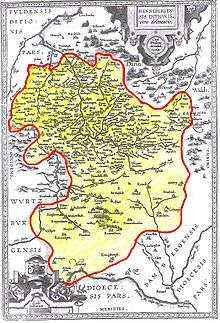
In the 11th century, the dynasty's estates around the ancestral seat Henneberg Castle near Meiningen belonged to the German stem duchy of Franconia. They were located southwest of the Rennsteig ridge in the Thuringian Forest, then forming the border with the possessions held by the Landgraves of Thuringia in the north. In 1096 one Count Godebold II of Henneberg served as a burgrave of the Würzburg bishops, his father Poppo had been killed in battle in 1078. In 1137 he established Vessra Abbey near Hildburghausen as the family's house monastery.
The counts lost their position as the bishops were raised to "Dukes of Franconia" in the 12th century. Nevertheless, in the course of the War of the Thuringian Succession upon the death of Landgrave Henry Raspe, Count Herman I of Henneberg (1224–1290) in 1247 received the Thuringian lordship of Schmalkalden from the Wettin margrave Henry III of Meissen. After the extinction of the Bavarian House of Andechs upon the death of Duke Otto II of Merania in 1248, the Counts of Henneberg also inherited their Franconian lordship of Coburg (then called the "new lordship", later Saxe-Coburg).
In 1274 the Henneberg estates were divided into the Schleusingen, Aschach-Römhild and Hartenberg branches. Count Berthold VII of Henneberg-Schleusingen (1272–1340) was elevated to princely status in 1310, his estates comprised the towns of Schmalkalden, Suhl and Coburg. In 1343 the Counts of Hennberg also purchased the Thuringian town of Ilmenau. The Coburg lands passed to the Saxon House of Wettin upon the marriage of Countess Catherine of Henneberg to Margrave Frederick III of Meissen in 1347.
After the Imperial Reform of 1500, the County of Henneberg formed the northernmost part of the Franconian Circle, bordering on the Upper Saxon Ernestine duchies and the lands of the Upper Rhenish prince-abbacy of Fulda in the northwest. A thorn in the side remained the enclave of Meiningen, a fief held by the Bishops of Würzburg, which was not acquired by the counts until 1542.
Disestablishment
Whereas the male line of the House of Babenberg became extinct in 1246, the Counts of Henneberg lived on until 1583. In 1554 William IV of Henneberg-Schleusingen had signed a treaty of inheritance with Duke John Frederick II of Saxony. However, when the last Count George Ernest of Henneberg died, both the Ernestine and the Albertine branch of the Wettin dynasty claimed his estates, that were finally divided in 1660 among the Ernestine duchies of Saxe-Weimar and Saxe-Gotha and the Albertine duke Maurice of Saxe-Zeitz. The Lordship of Schmalkalden fell to Landgrave William IV of Hesse-Kassel, according to an inheritance treaty of 1360.
After the Congress of Vienna (1815), the former Albertine parts around Schleusingen and Suhl fell to the Prussian province of Saxony. King Frederick William III of Prussia assumed the title of a Princely Count of Henneberg, which his successors in the House of Hohenzollern have borne ever since.
Counts of Henneberg
Partitions of Henneberg under Henneberg rule
| County of Henneberg (1052-1091) | |||||||
| County of Frankenstein (Popponian line) (1091-1354) | |||||||
| County of Henneberg-Botenlauben (1190-1234) |
County of Henneberg-Wurzburg (1190-1218) |
||||||
| Sold to the Diocese of Würzburg | County of Henneberg (Gotboldian line) (1190-1262) |
County of Frakenstein-Irmelshausen (1144-1255) | |||||
| County of Henneberg-Coburg (1245-1291) |
|||||||
| County of Henneberg-Schleusingen (1262-1583) |
County of Henneberg-Hartenberg (1262-1371) |
County of Henneberg-Aschach (1262-1535) |
|||||
| Annexed to the Margraviate of Brandenburg-Salzwedel | |||||||
| Inherited by the Stein zu Nord- und Ostheim family | |||||||
| County of Henneberg-Aschach-Römhild (1535-1549) |
County of Henneberg-Aschach-Schwarza (1535-1549) | ||||||
| Sold to the County of Mansfeld, and in 1555 was sold again to the Electorate of Saxony | Annexed to the County of Stolberg | ||||||
| Divided between the Electorate of Hesse and the Electorate of Saxony | |||||||
Table of rulers
(Note: Here the numbering of the counts is the same for all counties, as all (or at least the majority of them) were titled Counts of Henneberg, despite of the different parts of land and its particular numbering of the rulers. The princes are numbered by the year of their succession.)
| Ruler | Born | Reign | Death | Ruling part | Consort | Notes | |
|---|---|---|---|---|---|---|---|
| Poppo I | 1040 | 1052-1078 | 7 August 1078 | County of Henneberg | Hildegard of Thuringia two children | Founder of the county. Died fighting in the Battle of Mellrichstadt. | |
| Gotebold I | c.1040 | 1078-1091 | c.1091 | County of Henneberg | Unmarried | Brother of the predecessor, left no heirs. The county was divided between the sons of Poppo I. | |
| Gotebold II | c.1070? | 1091-1144 | 20 October 1144 | County of Henneberg-Henneberg (Goteboldian line) | Lutgard of Hohenberg six children | Son of Poppo I, inherited Henneberg. | |
| Poppo II | c.1040 | 1091-1118 | 21 August 1118 | County of Frankenstein (Popponian line) | Beatrix of Gleichen four children | Son of Poppo I, inherited Frankenstein. | |
| Poppo III | c.1100 | 1118-1156 | 1156 | Frankenstein-Irmelshausen | Unknown three children | Son of Poppo II, inherited Irmelshausen. | |
| Louis I | c.1100 | 1118-1164 | 1164 | County of Frankenstein | A woman from Zimmern five children | Son of Poppo II, inherited Frankenstein. | |
| Poppo IV | c.1128 | 1144-1156 | 1 September 1156 | County of Henneberg-Henneberg | Irmgard of Stade no children |
Sons of Gotebold II, probably ruled jointly. | |
| Berthold I | c.1130 | 1156-1159 | 18 October 1159 | County of Henneberg-Henneberg | Bertha of Putelendorf three children | ||
| Poppo V | c.1150? | 1156-1199 | 29 May 1199 | Frankenstein-Irmelshausen | Irmgard of Rothausen one child |
Sons of Poppo III, probably ruled jointly. | |
| Henry I | c.1150? | 1156-1167 | 1167 | Frankenstein-Irmelshausen | Unmarried | ||
| Poppo VI | c.1150? | 1159-1190 | 14 June 1190 | County of Henneberg-Henneberg | Sophia of Andechs c.1182 four children | ||
| Louis II | c.1150? | 1164-1197 | 1197 | County of Frankenstein | Unknown two children | ||
| Berthold II | c.1170? | 1190-1212 | 24 August 1212 | Henneberg-Würzburg | Kunigunde of Abensberg one child Matilda of Esvelt no children | Son of Poppo VI, inherited Würzburg. | |
| Poppo VII | c.1170? | 1190-1245 | 21 August 1245 | County of Henneberg-Henneberg | Elisabeth of Wildburg 1217 four children Jutta of Thuringia 3 January 1223 Leipzig five children | Son of Poppo VI, inherited Henneberg, and in 1218, Würzburg. | |
| Otto I |  | c.1177 | 1190-1234 | 3/4 October 1244 | Henneberg-Botenlauben | Beatrix de Courtenay 1208 three children | Son of Poppo VI, inherited Botenlauben. In 1234 sold it to the Diocese of Würzburg. |
| Otto II | c.1200? | 1220-1234 | 22 September 1249 | Henneberg-Botenlauben | Adelaide of Hildenburg 1228 one child | Son of Otto I, probably co-ruled with his father. | |
| In 1234 Botenlauben was sold to the Diocese of Würzburg | |||||||
| Albert I | c.1170? | 1197-1233 | 26 October 1233 | County of Frankenstein | Unknown two children | ||
| Henry II | c.1170? | 1199-1228 | 6 December 1228 | Frankenstein-Irmelshausen | A woman from Wildberg five children | Died fighting in Meiningen. | |
| Berthold III | c.1190? | 1212-1218 | 1218 | Henneberg-Würzburg | Matilda of Hachberg no children | After his death with no heirs, Würzburg returned to Henneberg. | |
| In 1218 Würzburg was annexed to Henneberg. | |||||||
| Albert II | c.1190? | 1228-1253/55 | Between October 1253 and 31 January 1255 | Frankenstein-Irmelshausen | Matilda of Trimberg one child | Left a daughter, who married count Henry of Frankenstein and so returned Irmelshausen to Frankenstein. | |
| In 1255 Irmelshausen was annexed to Frankenstein. | |||||||
| Louis III | c.1190? | 1233-1263 | 11 January 1263 | County of Frankenstein | Unknown two children | ||
| Herman I | c.1224 | 1245-1290 | 18 December 1290 | Henneberg-Coburg | Margaret of Holland 1249 two children | Son of Poppo VII, inherited Coburg. | |
| Henry III | c.1226 | 1245-1262 | 9 April 1262 | County of Henneberg-Henneberg | Elisabeth of Teck four children Sophia of Meissen three children | Son of Poppo VII, inherited Henneberg. | |
| Henry IV | c.1250 | 1262-1317 | Between 9 September and 17 December 1317 | Henneberg-Hartenberg | Margaret of Meissen no children Kunigunde of Wertheim 3 May 1287 seven children |
Sons of Henry III, inherited Hartenberg, where they probably ruled jointly. Berthold became Bishop of Würzburg in 1267, and possibly abdicated from the co-regency. | |
| Berthold IV | 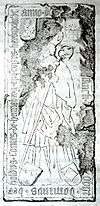 | c.1250 | 1262-1267 | 29 September 1312 | Henneberg-Hartenberg | Unmarried | |
| Berthold V | 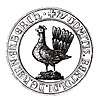 | c.1245 | 1262-1284 | 15 September 1284 | Henneberg-Schleusingen | Sophia of Schwarzburg c. or before 7 March 1268 Elgersburg eight children | Son of Henry III, inherited Schleusingen. |
| Herman II | c.1250 | 1262-1292 | 9 February 1292 | Henneberg-Aschach | Adelaide of Trimberg 25 March 1277 six children | Son of Henry III, inherited Aschach. | |
| Henry V | c.1230? | 1263-1295 | 22 December 1295 | County of Frankenstein | Lutgard of Henneberg-Schleusingen eight children | Son of Poppo II, inherited Frankenstein. | |
| Berthold VI the Younger | 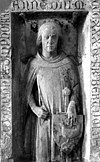 | c.1280 | 1284-1330 | 21 January/August 1330 | Henneberg-Schleusingen | Unmarried | Sons of Berthold V, ruled jointly.[1] Berthold VI was Knight Hospitaller, and Berthold VII was made regent for Louis V of Bavaria between 1323 and 1330. |
| Berthold VII the Wise[1] | 1272 | 1284-1340 | 13 April 1340 | Henneberg-Schleusingen | Adelaide of Hesse 1284 five children Anna of Hohenlohe no children | ||
| Poppo VIII | c.1254 | 1290-1291 | 4 December 1291 | Henneberg-Coburg | Sophia of Bavaria 1277 Landshut no children | After his death, his sister Judith inherited the county and so it was annexed to Brandenburg. | |
| In 1291 Coburg was annexed to the Margraviate of Brandenburg-Salzwedel | |||||||
| Henry VI | c.1280 | 1292-1355/6 | Between 14 August 1355 and 26 January 1356 | Henneberg-Aschach | Sophia of Käfernburg c.3 March 1315 five children |
Sons of Herman II, ruled jointly. | |
| Herman III | c.1277 | 1292-1307 | 12 July 1307 | Henneberg-Aschach | Katharina of Głogów no children | ||
| Poppo IX | c.1280 | 1292-c.1350 | After 1362 | Henneberg-Aschach | Unmarried | ||
| Berthold VIII | c.1280 | 1292-1329 | After 1329 | Henneberg-Aschach | |||
| Herman IV | c.1280 | 1292-1329 | 10 December 1329 | Henneberg-Aschach | |||
| Henry VII | c.1270? | 1295-1326/7 | Between 26 April 1326 and 25 March 1327 | County of Frankenstein | Elisabeth of Thuringia 11 April 1291 seven children |
Sons of Henry I, probably ruled jointly. In 1255 they inherited the county of Irmelshausen by the marriage of Henry VIII with the heiress Lutgard. | |
| Henry VIII | c.1270? | 1295-1297 | c.1297 | County of Frankenstein | Lutgard of Frankenstein-Irmelshausen 11 April 1291 no children Judith no children | ||
| Poppo X | 1286 | 1317-1349 | 30 July 1349 | Henneberg-Hartenberg | Elisabeth of Castell no children Richeza of Hohenlohe 6 November 1316 five children | ||
| Louis IV | c.1270? | 1326/7-1334 | September/October 1334 | County of Frankenstein | Adelaide of Weilnau two children | Brother of the predecessors. Left a daughter, Elisabeth, who later transferred the county to the Von Stein zu Ostheim family. | |
| Siboto | c.1290? | 1334-1335 | Between 26 April 1326 and 25 March 1327 | County of Frankenstein | Unmarried | Son of Henry II. | |
| Dietzel | c.1310? | 1335-1354 | 29 September 1354 | County of Frankenstein | Unmarried | Nephew of Siboto. After his death, his second cousin Elisabeth transferred the county to the Von Stein zu Ostheim family. | |
| In 1354 Frankenstein was added to the patrimony of the Von Stein zu Ostheim family | |||||||
| John I | 1289 | 1340-1359 | 2 May 1359 | Henneberg-Schleusingen | Elisabeth of Leuchtenberg 1349 four children |
Sons of Berthold VI, ruled jointly. Berthold VIII was a Knight Hospitaller. | |
| Henry IX the Younger | 1288 | 1340-1347 | 10 September 1347 | Henneberg-Schleusingen | Judith of Brandenburg-Salzwedel 1 January 1317 or 1 February 1319 five children | ||
| Berthold IX | 1300 | 1340-1356 | c.1356 | Henneberg-Schleusingen | Unmarried | ||
| Berthold X[1] | c.1330/40 | 1349-1371 | 26 May 1378 | Henneberg-Hartenberg | Unmarried | Left no heirs, and in 1371 sold Hartenberg to the Herman IV. | |
| In 1371 Hartenberg was sold to Aschach | |||||||
| Herman V | c.1330 | 1355/6-1403 | 27 January or 28 March 1403 | Henneberg-Aschach | Adelaide of Zollern no children Agnes of Schwarzburg-Blankenburg 1366 four children |
Son of Henry VI, probably ruled jointly. | |
| Berthold XI | c.1330 | 1355-1411 | 1 April 1411 | Henneberg-Aschach | Unmarried | ||
| Henry X | c.1340/50 | 1359-1405 | 2/3 August 1405 | Henneberg-Schleusingen | Matilda of Baden c.4 July 1376 six children |
Sons of John I, ruled jointly. Berthold was canon at Bamberg and resigned his noble titles in 1375.[1] | |
| Berthold XII[1] | 1356 | 1359-1375 | 11 February 1416 | Henneberg-Schleusingen | Unmarried | ||
| Frederick I | 1367 | 1405-1422 | 24 September 1422 | Henneberg-Aschach | Elisabeth of Henneberg-Schleusingen c.4 May 1393 four children |
Sons of Herman V, probably rule jointly. | |
| Herman VI | c.1370 | 1405-1416 | 11 September 1416 | Henneberg-Aschach | Unmarried | ||
| William I | 31 July 1384 | 1405-1426 | 7 July 1426 | Henneberg-Schleusingen | Anna of Brunswick-Lüneburg c.30 May 1413 nine children | ||
| George I | 1395 | 1422-1465 | 25 July 1465 | Henneberg-Aschach | Katharina of Wertheim no children Joanna of Nassau-Saarbrücken 13 May 1423 twelve children | ||
| Herman VII | c.1430 | 1450/60-1464 | 13 February 1464 | Henneberg-Aschach | Unmarried | Probably ruled with his father. | |
| William II | 14 March 1415 | 1426-1444 | 8 January 1444 | Henneberg-Schleusingen | Katharina of Hanau 28 February 1433 seven children | ||
| William III | 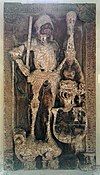 | 12 March 1434 | 1444-1480 | 25 May 1480 | Henneberg-Schleusingen | Margaret of Brunswick-Wolfenbüttel 5 November 1469 Wolfenbüttel eight children |
Sons of William II, probably ruled jointly. Bethold XIV died as a minor, Berthold XV became canon at Bamberg in 1452, and John II became also canon in the ame year at Strasbourg, so they may have probably resigned co-regency. |
| John II | 2 July 1439 | 1444-1452 | 20/26 May 1513 | Henneberg-Schleusingen | |||
| Berthold XIII | 8 January 1441 | 1444-1446 | 20 April 1446 | Henneberg-Schleusingen | |||
| Berthold XIV | 4 March 1443 | 1444-1452 | 20 April 1495 | Henneberg-Schleusingen | |||
| Otto III |  | 1437 | 1465-1502 | 9 June 1502 | Henneberg-Aschach | Unmarried | Sons of George I, ruled jointly. In 1484 Berthold became Archbishop of Mainz, probably abdicating from co-regency. |
| Frederick II | 1429 | 1465-1488 | 7 November 1488 | Henneberg-Aschach | Elisabeth of Württemberg I 13 September 1469 Münnerstadt twelve children | ||
| Berthold XV | 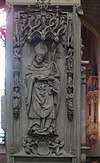 | 1442 | 1465-1484 | 21 December 1504 | Henneberg-Aschach | Unmarried | |
| Margaret of Brunswick-Wolfenbüttel (regent) | 1451 | 1480-c.1492 | 13 February 1509 | Henneberg-Schleusingen | William III 5 November 1469 Wolfenbüttel eight children | Regent for her minor sons, Poppo XI William IV. | |
| Poppo XI | 14/17 March 1479 | 1480-1483 | 14/24 May 1483 | Henneberg-Schleusingen | Unmarried | Died as a minor. | |
| William IV |  | 29 January 1478 | c.1492-1559 | 24 January 1559 | Henneberg-Schleusingen | Anastasia of Brandenburg 7 or 16 February 1500 Neustadt an der Aisch eleven children | |
| John III |  | 30 April 1503 | c.1520-1529 | 20 May 1541 | Henneberg-Schleusingen | Unmarried | Probably co-ruled with his father. Became Prince-abbot in Fulda in 1529, probably abdicating from the co-regency. |
| Herman VIII |  | 1470 | 1502-1535 | 5 April 1535 | Henneberg-Aschach | Elisabeth of Brandenburg 23 October 1491 Aschaffenburg nine children | After his death, his sons divided Aschach. |
| Berthold XVI | 1493 | 1535-1549 | 23 March 1549 | Henneberg-Aschach-Römhild | Anna of Mansfeld-Vorderort 17 August 1529 no children | Son of Herman VIII, inherited Römhild. After his death, his county was sold to the County of Mansfeld. | |
| In 1549 Römhild was sold to the County of Mansfeld, and in 1555 it was sold again to the Electorate of Saxony | |||||||
| Albert III | 1495 | 1535-1549 | 5 May/June 1549 | Henneberg-Aschach-Schwarza | Katherine of Stolberg 1537 no children | Son of Herman VIII, inherited Schwarza. After his death, his county was annexed to the County of Stolberg. | |
| In 1549 Schwarza was annexed to the County of Stolberg | |||||||
| George Ernest |  | 27 May 1511 | 1559-1583 | 27 December 1583 | Henneberg-Schleusingen | Elisabeth of Brunswick-Calenberg 19 August 1543 Münden one child Elisabeth of Württemberg II 31 May 1568 Stuttgart no children |
Sons of William IV, ruled jointy, and neither of them left descendants. After their death, the county was divided between the Electorate of Hesse and the Electorate of Saxony. |
| Poppo XII | 20 September 1513 | 1559-1574 | 4 March 1574 | Henneberg-Schleusingen | Elisabeth of Brandenburg 30 May 1546 Münden no children Sophia of Brunswick-Lüneburg 22 June 1562 Schleusingen no children | ||
| In 1583 Schleusingen was divided between the Electorate of Hesse and the Electorate of Saxony | |||||||
Notable members of the Henneberg family
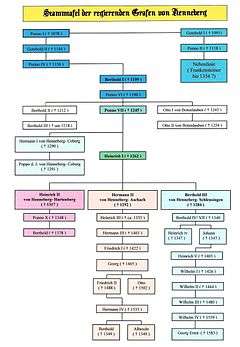
- Bertold von Henneberg-Römhild (1442 – December 21, 1504), Prince-elector and archbishop of Mainz, son of George, count of Henneberg-Römhild.
- Count Otto von Henneberg, known commonly as Otto von Botenlauben from 1206, probably born in 1177 in Henneberg, died in Reiterswiesen near Bad Kissingen before 1245, was a German minnesinger, crusader and founder of Frauenroth Abbey.
- Herman I, Count of Henneberg
- Catherine of Henneberg
- William II, Princely count of Henneberg-Schleusingen
- William III, Princely count of Henneberg-Schleusingen
- William IV, Princely count of Henneberg-Schleusingen
Castles

- Bertholdsburg Castle, Schleusingen
- Römhild Castle

Coats of arms incorporating Henneberg
See also

- Bishopric of Würzburg
- Vessra Abbey
- Aura Abbey
- Römhild
- Sondheim vor der Rhön
- Münnerstadt
- Irmelshausen
- Bad Kissingen (district)
- Poppo
- William II, German Emperor/Scraps
- Schmalkalden-Meiningen
- Wartburgkreis
- Hildburghausen (district)
- List of states in the Holy Roman Empire (H)
References
- Detlev Schwennicke: Europäische Stammtafeln, Neue Folge, Band XVI., Tafel 146, Verlag: Vittorio Klostermann, Frankfurt a. M. 1995, ISBN 3-465-02741-8
- Schwennicke, Detlev. Europäische Stammtafeln: Stammtafeln zur Geschichte der Europäischen Staaten, Neue Folge. [European Family Trees: Family Trees for the History of European States, New Series.] BAND II, Tafel 10:Die Robertiner I und die Anfänge des Hauses Capet, 922-923 König der Westfranken, Marburg, Verlag von J.A. Stargardt (1984)
- Historische Landkarte: Grafschaft Henneberg 1755 mit den Ämtern Schleusingen, Suhl, Kühndorf mit Bennshausen, Reprint 2003, Verlag Rockstuhl, ISBN 3-936030-15-4
- Johannes Mötsch: Regesten des Archivs der Grafen von Henneberg-Römhild. Volumes 1 und 2. Böhlau, Köln etc. 2006, ISBN 978-3-412-35905-8
External links

- Henneberg Genealogy
- (in German) Direct male descent of Babenberger from Robertiner (Capet) family, in the German Wikipedia
- (in German) Early Babenberger genealogy, in the German Wikipedia




